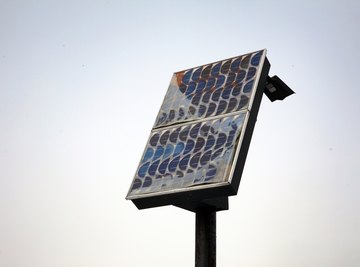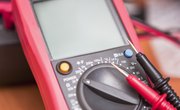
Small solar panels have become widely available through many retail outlets. A 60-watt panel delivers a middling amount of power, able to run pumps, power small electronic devices, charge batteries and perform other useful tasks. Because the solar panel's useful power output is limited to about five hours a day, combining it with a battery and recharging system improves the panel's usefulness.
Solar Panel Power
A typical 60-watt solar panel generates direct current electricity between about 12 to 18 volts; according to Ohm's law for electrical power, 60 watts divided by 18 volts gives you 3 amperes of current. Its power varies, depending on the position of the sun in the sky and weather; 60 watts may be an average figure or it may be the peak power, depending on the panel's specifications. Although its direct current output means you can run DC-powered devices with it, an alternating current inverter makes the panel useful with standard 110-volt AC equipment. Because the inverter itself uses some of the solar panel's power, you end up with less than 60 watts, although it'll be enough to run small gadgets.
Battery Charger
Battery charging is a common application for solar panels for two main reasons: batteries accumulate power over time, providing more when you need it, and you can use battery power at night. A solar panel used to trickle-charge a car's lead-acid battery keeps the battery from going dead after months of disuse.You cannot simply connect a solar panel directly to a battery because it will discharge through the panel at night, leaving the battery dead. A blocking diode will prevent battery discharge; a more sophisticated electronic regulation system is even better. Retailers sell battery charging systems that are ready to work with solar panels.
Water Pump
A solar panel can run a DC-powered electric water pump, such as for a garden fountain, or to supply household water from a well. The low-voltage wiring from the solar panel is safer and easier to run, indoors or out, than that for standard 110-volt AC power. Because the solar panel is independent of AC power, you can locate the pump nearly anyplace that receives regular sunlight.
Computers
Although the power from a single 60-watt solar panel is not enough to run a desktop computer, it is sufficient for a small laptop computer. Computer makers design laptops to be very energy efficient, as they are meant to run on battery power. Before you can run the laptop from a solar panel, you must match the panel's voltage to the computer's. If the laptop needs a higher voltage than what the panel provides, you can use a DC-to-DC converter device to increase the voltage.
Lighting and Signs
You can use a 60-watt solar panel to power light-emitting diode signs and lighting. LEDs are much more energy-efficient than traditional incandescent lamps, and depending on the lighting system, you can run a string of LEDs on the low-voltage DC power the panel produces. For lighting at night, you'll need a battery and charging system to store electricity during the daylight hours.
References
About the Author
Chicago native John Papiewski has a physics degree and has been writing since 1991. He has contributed to "Foresight Update," a nanotechnology newsletter from the Foresight Institute. He also contributed to the book, "Nanotechnology: Molecular Speculations on Global Abundance." Please, no workplace calls/emails!
Photo Credits
Jupiterimages/Photos.com/Getty Images
